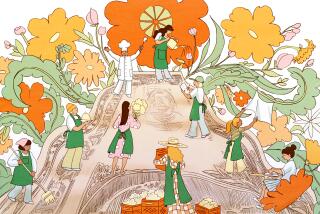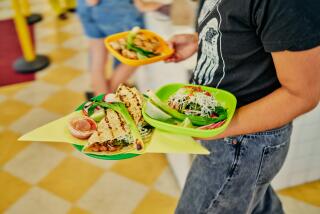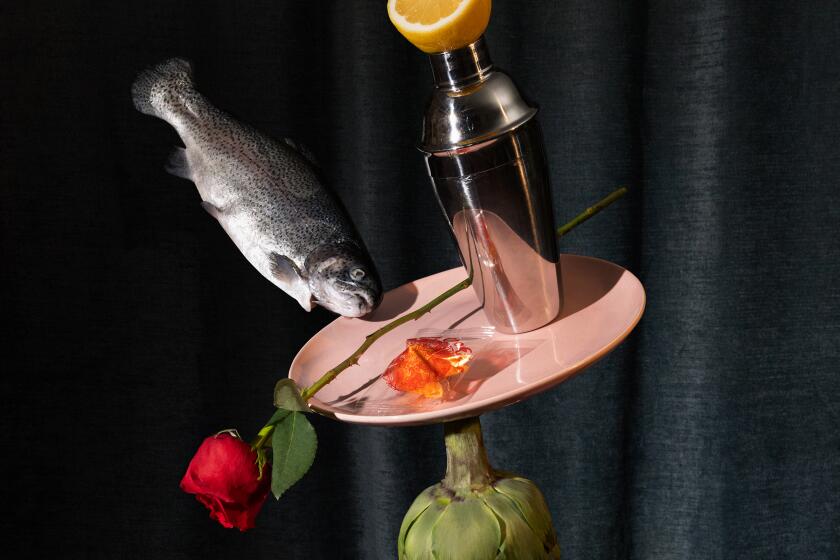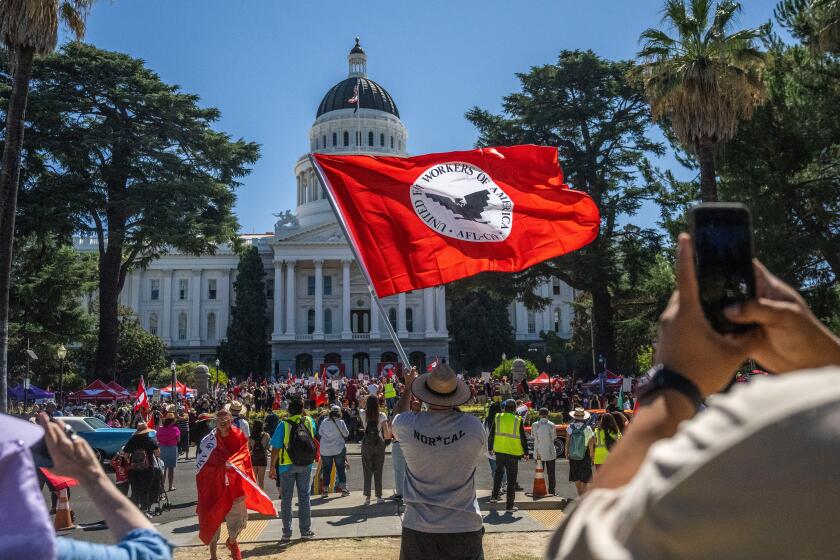BREWS
Not often is Southern California dead last in a trend. But America’s resurgent love affair with beer--the extraordinary quality and variety of today’s beer, the comfortable settings where beer draws friends together--is, alas, barely a flirtation here.
Yes, good beer can be found if you look. But not always. And scattered around are ale houses and brew pubs where an appreciation of beer is learned and passed on. But they are scarce and it’s luck to find one handy.
At this moment, I am at Crown City Brewery in Pasadena enjoying a pint of Arroyo Amber ale, which I rate as pretty fine. Naturally, I’m here with friends because beer, at its heart, is social. I rate my friends as better than fine--even the poor soul who is tempted to order a watery, mass-produced American lager of the kind advertised for college boys with a promise that under the label is an image. This friend knows no better, how could she? But by the end of our evening she will.
Beer is not a uniform thing. And while I find that most people now concede the point in conversation, I’m still puzzled by the number of acquaintances who go only so far as to divide beer into two categories: the faint industrial brew with which they are familiar and all the other stuff that is darker, heavier, higher alcohol. The fact is that none of these characteristics is necessarily true in craft beers.
A chocolate-colored ale like British Brown can be richly flavorful but still lower in alcohol than a bright yellow German-style lager. To the palate, the difference is as great as say, between potato salad and green salad.
Tossing out misconceptions and exploring the range of taste, texture and aftertaste is what drives the heady, good fun of the American beer renaissance. How do you match beer with food? What is Lambic? Why is a German pilsener so special to the palate in Bavaria and so ordinary here? Which wheat beers are complemented by a slice of lemon? What’s the difference between microbrew and contract beer?
Folks, we’re lagging behind.
Beer is made from the same ingredients as bread--grain, yeast and water, with the addition of the flower-like cone from the hop plant for flavor. Like bread, it comes in endless variety and the fresher the better. So why are Southern California restaurants with puffed-up pride in their wine lists, or party hosts out to impress, still offering me the equivalent of a stale slice of balloon bread when I inquire about their beer?
The best place to develop your appreciation for fine beer is an established brew pub, where beer is made on premises, or an ale-house, where beer is served in variety and handled properly.
Going on its 10th year, Crown City is one of the oldest brew pubs in the region, and from what I have seen has a loyal following. This evening, it offers 25 beers on draught, six made under this roof. Real purists might say that 25 is too many taps to assure freshness, but unless your tastes are uncommonly refined you will not notice.
Crown City also sells 170 or so different bottled beers. I’ll take their word for it. Ordering bottled beer at a pub is like asking for the freezer section at a bakery.
I cannot call Crown City my pub. Because I have to drive a half-hour to get here. Any pub you call your own has to be part of your everyday community. Otherwise, you are a visitor. Dennis Hartman, one of the partners in Crown City, says his typical customer walks in from the neighborhood three times a week, and 70% arrive in groups to enjoy beer socially.
Perhaps this explains why Southern California has fallen behind in the fun--not just behind the beer capitals of Portland and Seattle, but other big metro areas like Washington, D.C., and even behind remote communities like Anchorage. Our car culture and rambling neighborhoods work against the existence of pubs.
Beer is tasty and promises levels of appreciation to satisfy even the most obsessive tastes. And where the competition among brewers and pubs is liveliest, things can get downright refined. But beer is not an end itself. Time with friends in easy surroundings, sharing a pleasure, that’s the end.
So you might be fortunate in your choice of neighborhood. Hop-head friends recommend Goat Hill Tavern in Costa Mesa, which pours from 141 taps--far too many for me, but not for everyone it appears. Don’t bother talking about trends at Blackie’s by the Sea in Newport Beach. The tiny establishment has been in business for 45 years and doesn’t even list its phone number. More contemporary is the Yard House in Long Beach with an astonishing 250 taps. In Silver Lake, there is the eccentric Red Lion Tavern, specializing in good German beers. Other establishments, big and small, are sprinkled around the region.
For the rest of us, there is another strategy. Expand your circle of neighborhood friends until you find a home-brewer. They’re quietly spreading throughout Southern California, helping the beer revival with their own hands. With equipment and ingredients now available, and with a wealth of books and newsletters to show the way, they are producing some alarmingly good brew. My favorite beer locally is the beer I make on my kitchen stove, that I pour for my friends in my living room. Doesn’t a creamy Dunkle Weizen sound just perfect for Octoberfest?
More to Read
Eat your way across L.A.
Get our weekly Tasting Notes newsletter for reviews, news and more.
You may occasionally receive promotional content from the Los Angeles Times.






